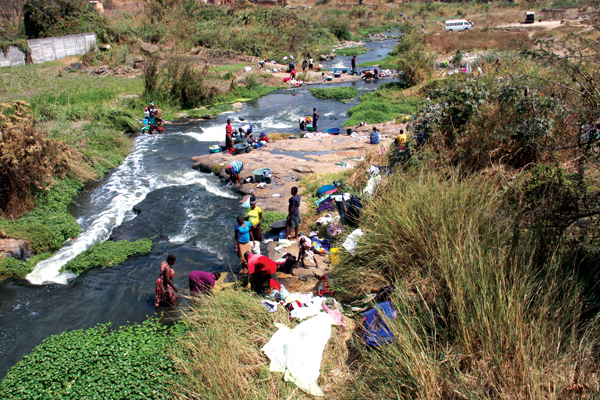
guest column:Peter Makwanya
MANY streams, rivers and other water bodies are threatened, have just been lost or degraded due to untoward human behaviours and practices. All water bodies combined, play instrumental roles in enhancing human livelihoods and ecological functions through human and animal water consumption, moisture retention and other river basin best practices. Due to poverty, lack of information, lack of significant employment and environmental legal gaps, communities have turned to rivers and streams for gold panning, streambank cultivation and other eco-freaky activities that contribute to soil erosion, river siltation and subsequent drying up.
Rivers and streams which usually influence the people’s lives in larger and sustainable ways, are now doing so in bad ways. Rivers were once arteries and vessels that shaped the people’s way of living and survival strategies. They defined communities’ culture, identity and socio-economic status. Even the communities’ settlement patterns were designed along the water bodies because water is life. These once imposing water bodies are now a figment of their former selves, having been choked by siltation while erosion has transported unwanted materials from the degraded landscapes nearby into the rivers, streams and other water bodies alike, thereby changing their complexion and composition. This is due to unregulated human flirtations and subversions of the natural laws and order of things.
Although rivers have been carriers of the communities’ sources of livelihoods for quite some time now, people in developing countries have not yet developed a culture of repairing and restoring damaged rivers. This may be attributed to related costs, ignorance of how best they can utilise locally available resources to strengthen and transform the status of their water bodies. People always watch haplessly and hopelessly as these streams and rivers disintegrate as a result of several environmental injustices having been committed, in the name of greed, agricultural production or industrial expansion.
Before the communities are to participate in river restoration projects, communication awareness and education programmes should be delivered and networked to the people. Quite a number of communities are not aware that they have responsibilities upon their shoulders to monitor and preserve their essential water sources. These are some of the ecological communication and procedural gaps that communities have to practise and manage so that they strengthen their natural bond with the environment, as their only source of livelihoods, in reciprocal ways.
But it should also be noted that, it’s not only careless human activities which have contributed to the demise of these water bodies, but also natural means like violent floods, storms or winds. As a result, it is not only streams; and rivers which are threatened with extinction, but also a number of wetland areas and ponds, have long gone, fuelling small and larger scale water conflicts in the process. At the inception of our independence, Zimbabwean communities descended on river basins and tilled the landscapes adjacent to the rivers and streams, and guess what, the results were disastrous, as streams and rivers which used to flow perennially, got silted and eroded matter accumulated and settled in rivers. As a result, some of these water sources are no longer traceable, they have since vanished. They have vanished because communities viewed these demises as the natural order of events, which they had no control over. They thought they had no business in doing anything that would see these water sources regenerated.
Even some dams are heavily silted and their holding capacities have been severely compromised. They are no longer as reliable and supportive as they used to be. The survival and maintenance of water bodies is often paid lip-service to or rather taken for granted, even at national level.
Although restorations and recoveries of defunct rivers is not that easy, communities and authorities concerned should, at least be seen to be doing something in order to demonstrate their relevance. Communities can be excused for anticipating divine intervention because that’s all what human nature is anyway, but we would not expect national water authorities to subscribe to the concept of divine intervention as well. After all, in water management there is not going to be any second coming of Jesus Christ. That is why my fellow columnist and academic, Tapiwa Gomo, in his climate change article lamented over the cost of climate change and that of doing nothing.
- Chamisa under fire over US$120K donation
- Mavhunga puts DeMbare into Chibuku quarterfinals
- Pension funds bet on Cabora Bassa oilfields
- Councils defy govt fire tender directive
Keep Reading
The restoration of rivers through rehabilitative means is not designed and aimed at creating something new, but just to achieve resilience, through taking care of wholesale protection of ecological frameworks. The sad thing about some of these rivers that have managed to survive destruction is that they have not succeeded in escaping pollution and the Hunyani River is the best example. Streams and rivers that pass through urban areas have all the ingredients of pollution from industrial discharge, raw sewage and other ecological footprints.
These days it is easy to cry about climate change, but climate change is just a result of unsustainable human behaviours and environmental injustices, which require strong communication tools and networking to manage. The power of communication in changing human behaviour has not been sufficiently utilised and recognised. That is why things are disintegrating and falling apart, only because of failing to invest in words, images and visuals.
Climate change has its own tolls which include frequent droughts, seasonal shifts and erratic rainfall patterns or temperature variabilities, which may also contribute to reduced water levels in rivers, streams and dams. By rehabilitating these water bodies, this becomes a strong mitigation measure as restoration improves the capability of any water body to conserve and hold water. Streams are arteries connected to rivers and flood plains, so they are there to sufficiently manage flood risks.
Many people invade river beds looking for well-grown trees so that they can harvest them, not knowing or caring very little about the contributions of trees to ecological preservation. Their role of holding the soils together, supporting grass growth, moisture retention and acting as carbon sinks is hardly remembered.
In this regard, streams and rivers should be kept flowing, not overflowing. Let us allow streams and rivers to keep making noise in order to improve the quietness of the seas.











